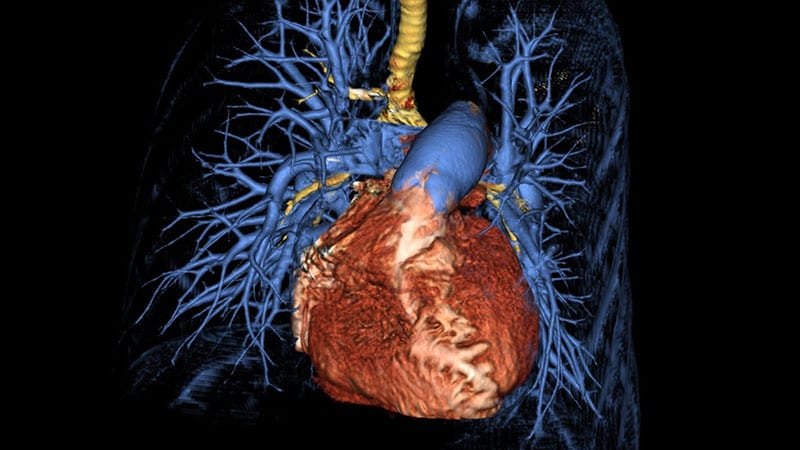Measuring amounts of cell-free DNA (cfDNA) in the blood can evaluate disease severity and predict survival in pulmonary arterial hypertension, according to a study from researchers at the National Institutes of Health.

Computed tomography 3D surface rendering of the lungs and heart from a patient with PAH showing trachea and major airways (yellow), an enlarged heart (red), enlarged main pulmonary artery (large blue vessel on top of heart) and thinning of the peripheral pulmonary vessels (blue).
In a prospective cohort study, patients with pulmonary arterial hypertension who had the highest level of cell-free DNA in their blood had almost a 4-times greater risk for death or need for lung transplantion compared with those with the lowest level of cell-free DNA.
The results are published in Circulation, a publication of the American Heart Association.
Pulmonary arterial hypertension (PAH) is a rare and lethal disease that predominantly affects women in the prime of their life. Despite 14 US Food and Drug Administration-approved therapies for PAH, some of which are invasive, survival remains poor.
Cell-free DNA is circulating short DNA fragments, predominantly from mononucleosomes that represent cell injury or cell turnover. Elevated total cfDNA concentration has been associated with worse prognoses in heterogeneous conditions such as sepsis, trauma, and malignancy.

Dr Michael A. Solomon
“Cell-free DNA (cfDNA) was already known to be a clinically relevant, noninvasive marker of solid organ transplant rejection, as well as a tool for surveillance in cancer,” coauthor Michael A. Solomon, MD, MBA, from the National Heart, Lung, and Blood Institute Cardiovascular Branch, and codirector of the National Institutes of Health Clinical Center Pulmonary Arterial Hypertension Section, Bethesda, Maryland, told theheart.org | Medscape Cardiology.
The similarities between these diseases and the processes underlying PAH, such as increased cell turnover and inflammatory-mediated tissue injury, prompted the researchers to look at whether plasma cfDNA concentrations were elevated in patients with PAH.
In the study, the researchers measured plasma cfDNA in blood samples taken from 209 adult patients, mostly women, diagnosed with PAH at two different medical centers: Allegheny General Hospital (cohort A; n = 48 patients) and Tufts Medical Center (cohort B; n = 161 patients), and compared the results with cfDNA measured in 48 healthy control participants.
They found that cfDNA was elevated in patients with PAH, and also that concentrations of cfDNA increased with the severity of disease. Patients with the highest level of cfDNA had a 3.8-times greater risk for either death or need for lung transplantation compared with patients with the lowest level of cfDNA.
Compared with controls, methylation analysis in patients with PAH showed that increased cfDNA originated from erythrocyte progenitors, neutrophils, monocytes, adipocytes, natural killer cells, vascular endothelium, and cardiac myocytes.
In addition, cfDNA concentrations derived from erythrocyte progenitor cells, cardiac myocytes, and vascular endothelium were greater in patients with PAH with high-risk Registry to Evaluate Early and Long-Term PAH Disease Management (REVEAL) scores compared with low-risk REVEAL scores (P < .02).
“Our study showed that circulating plasma cfDNA levels not only correlate with disease severity, but also predicts worse survival,” coauthor Sean Agbor-Enon, MD, PhD, from the NIH Clinical Center, told theheart.org | Medscape Cardiology.

Dr Sean Agbor-Enon
“The hope is that earlier recognition of a patient’s risk of death from the disease by a single noninvasive blood test will help higher risk patients with PAH get on the proper therapy sooner and thus also hopefully improve survival. In addition, the early identification of high-risk patients may allow these patients to better tolerate life-saving treatments such as lung transplantation,” Agbor-Enon said. “Transplantation decisions become more complex and the surgery may not be as beneficial when patients are much sicker.”
“We hope that the measurement of circulating plasma cell-free DNA levels will eventually become a commercially approved test to identify patients at risk of severe disease,” added Solomon. “Such a tool should simplify how we identify patients who will need certain treatments.”
A Very Important Paper

Dr Carlos Santos-Gallego
Commenting on this research for theheart.org | Medscape Cardiology, Carlos Santos-Gallego, MD, a cardiologist at Mount Sinai Hospital in New York City, said that the results of the study are clinically relevant and will have a significant impact on current clinical practice.
“Right now, there is no imaging or blood releated biomarker that predicts the severity and the prognosis of pulmonary arterial hypertension. We have some biomarkers, but none of them are very specific. With this biomarker, we can specifically measure patterns of tissue injury,” Santos-Gallego said.
The fact that cfDNA was validated in two independent cohorts is a strength of the paper, he added.
“This is important. The cohorts are not very large, but they are from 2 independent hospitals, and the patients are slightly different. Cohort B likely has more severe disease than cohort A, but the results are reproducible.”
Santos-Gallego noted that testing for plasma cfDNA could be a way of diagnosing PAH in its earlier stages.
“The symptoms, such as shortness of breath, muscle weakness, can be misdiagnosed. For example, some women will go to the doctor and their diagnosis will be missed. This test could pick up the diagnosis earlier,” he said.
Circulation. 2022. Published online August 25, 2022. Abstract
Solomon, Agbor-Enoh, and Santos-Gallego report no relevant financial relationships. The research was funded by the National Institutes of Health Clinical Center RASCL award, the National Institutes of Health Distinguished Scholar Award, the Lasker Clinical Research Scholars Program, and the Intramural Research Programs of the National Institutes of Health Clinical Center and the National Heart, Lung, and Blood Institute.
Source: Read Full Article
